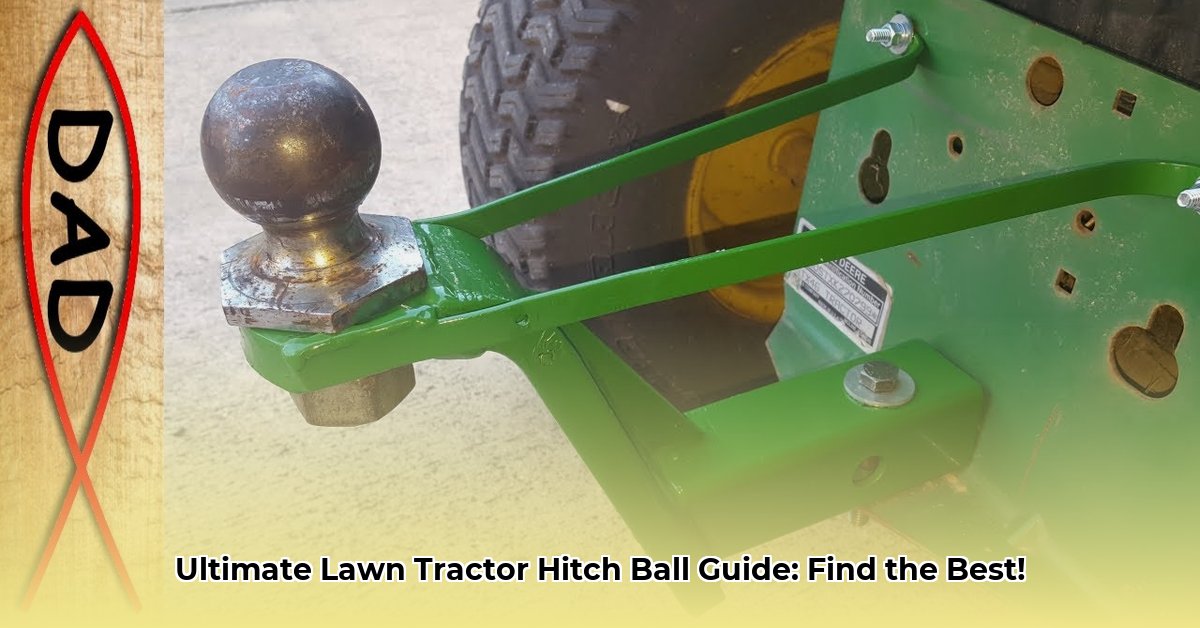
Choosing the Right Hitch Ball: Size Matters
Selecting the correct hitch ball is paramount for safe and efficient towing with your lawn tractor. Ignoring this crucial step can lead to accidents and damage to your equipment. The size of the hitch ball must precisely match the coupler on your trailer. Common sizes include 1 7/8 inches and 2 inches in diameter. But how do you know which size you need?
First, consult your lawn tractor's owner's manual to determine its maximum towing capacity. This information is crucial for safety. Next, weigh your loaded trailer. Using a truck scale is recommended for accurate measurement, especially for heavier loads. Exceeding your tractor's towing capacity is extremely dangerous. For added comfort, consider upgrading your seat; check out these lawn tractor seat options.
The hitch ball's diameter must precisely match the coupler on your trailer. A loose connection is a significant safety hazard. Here's a quick guide:
| Hitch Ball Diameter | Approximate Trailer Weight Capacity (lbs) | Considerations |
|---|---|---|
| 1 7/8" | Up to 3,500 | Suitable for smaller trailers and lighter loads. |
| 2" | Up to 5,000+ | Recommended for heavier trailers and larger towing jobs. |
Remember: These are estimates. Always refer to your tractor and trailer manuals for precise weight limits.
Installing Your Hitch Ball: A Step-by-Step Guide
Installing a hitch ball correctly is critical for safety. A poorly installed hitch ball can lead to accidents and equipment damage. Refer to your hitch manufacturer's instructions, as specific installation steps may vary. However, these general steps are a good starting point:
Secure the Hitch: Ensure your lawn tractor's hitch is firmly mounted and all bolts are tightly secured. A loose hitch compromises the entire setup's stability.
Insert the Ball: Gently slide the hitch ball into the receiver. It should fit snugly. If it requires force, something is wrong—re-check your work.
Tighten the Clamp: This is crucial! Tighten the clamp or bolt firmly, but avoid over-tightening, which can damage the hitch.
Test the Fit: Gently tug on the trailer to ensure a secure connection. Any movement indicates an issue – re-tighten or re-evaluate.
Pro Tip: A wobbly connection is incredibly dangerous, and attempting to tow with a loose ball poses serious safety risks.
Maintaining Your Hitch Ball: Essential Tips for Longevity & Safety
Regular maintenance is fundamental to a hitch ball's longevity and your safety. Neglecting maintenance significantly increases the risk of accidents.
Pre-Tow Inspection: Before each use, visually inspect your hitch for cracks, bends, excessive rust, and signs of wear. If you find any issues, replace the hitch ball immediately, ensuring your safety.
Lubrication: Periodically lubricate the hitch ball with a suitable lubricant to reduce friction, prevent rust, and extend its lifespan. This simple step can make a significant difference.
Weight Limits: Never, ever exceed the weight limits of your tractor, hitch, or trailer. This is the golden rule of safe towing.
Reviewing Hitch Balls: Factors to Consider
Choosing the right hitch ball involves several factors. Durability is key; you need a hitch ball that can withstand repeated use. Ease of installation is also a significant factor. Look for products with positive reviews emphasizing build quality and materials. While price matters, compromising safety for cost savings is unacceptable.
Did you know? Checking online reviews from reputable sources – think Amazon, Home Depot, or specialized agricultural equipment sites – helps you weigh the pros and cons of different models before you buy. A well-reviewed hitch indicates superior quality and safety.
Always confirm compatibility with your tractor's hitch receiver before purchasing. A perfect fit is crucial.
Key Takeaway: Choosing and maintaining the right hitch ball for your lawn tractor is essential for ensuring safe and efficient towing operations. Prioritizing safety through proper selection and maintenance will guarantee a positive experience.